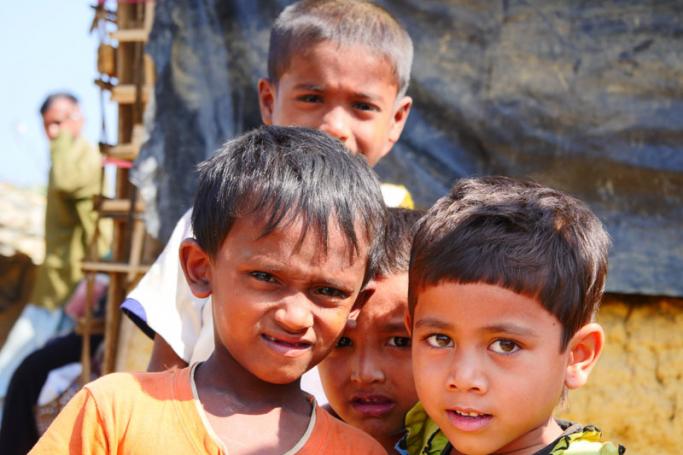It is a one-hour drive from the longest continual natural sea beach - one of Bangladesh’s favourite local tourist destinations located in Cox’s Bazar - to the dirt and squalor of the Kutupalong and Balukhali refugee camps close to the border to Myanmar. After passing several villages and local authority checkpoints, my driver signals that we have arrived while trying to drive around the crowds of refugees.
One of the things that strikes me most is the heavy smell of rubbish in the heat as we get out of the car, and the large numbers of children running around.
I approach a group of children playing between makeshift shelters to ask about their age. A man in the background replies that they are between six and ten years old.
When I ask him how long he has been in the camp, the man says that he has lived here since the early 1990s.
This is a painful reminder – while the Rohingya refugees have been in the spotlight over the last five months, the problem of an ethnic community in limbo has been dragging on for decades gaining little attention.
Experts claim the Muslim Rohingya are one of the most persecuted minorities in the world.
As I approach an aid distribution tent, an NGO worker tells me about their work in the overcrowded camps, and I learn about the recent deaths and increasing amount of diphtheria and cholera cases, with children particularly at risk. After speaking to another doctor from Kuwait to get the latest numbers of new infections, I start realising the risk of being exposed to these diseases without vaccination.
The size of the problem becomes more apparent as I travel through the area.
On the way to neighbouring Balukhali refugee camp, we pass by the transit centres run by UNHCR, where the most vulnerable new arrivals are provided with food, water and medical checks. At the entrance of Balukhali camp, a group of young men queue at a food distribution point, many of them waiting for several hours. That is when I realise the importance of local and foreign volunteers who come here to help with coordination and distribution of food and medical supplies.
An estimated 650,000 Rohingya people fled into Bangladesh from neighbouring Myanmar since August last year, in the wake of the military crackdown in the villages of northern Rakhine State after attacks by the Arakan Rohingya Solidarity Army against government security posts.
This is a major humanitarian disaster and a long time in the making.
The combined population of the displaced Rohingya population is approximately 820,000, most of whom live in makeshift settlements such as the Kutupalong and Balukhali refugee camps in Ukhia, a division of Cox’s Bazar district.
As the situation in the refugee camps is worsening, 31 deaths and 3,954 suspected cases of diphtheria have been reported from Cox’s Bazar between November 8, 2017, and January 11, 2018, according to the World Health Organization.
Médecins Sans Frontières (MSF), alongside other organisations, are on the ground to help treat rising number of patients with diphtheria and cholera diseases.
To limit the spread of disease a vaccination programme has been initiated by WHO, UNICEF and the Ministry of Health and Family Welfare on January 1, 2018, with nearly 160,000 children vaccinated in the Teknaf and Ukhiya sub-districts.
Mr. Edouard Beigbeder, UNICEF Country Representative, stresses the risk to the youngest of the refugees.
“Children are particularly vulnerable to diphtheria. Volunteers are making door-to-door visits in the Rohingya settlements to ensure all children receive the vaccination,” he said.
Mr Beigbeder said the massive influx within a very short time has heavily affected basic services in the settlement areas.
“They have no choice but to live in a very congested environment, which is impacting their health and quality of life. We are making continued efforts to improve conditions of the camps. At the same time, diphtheria vaccination is vital to reducing the risk of further outbreak,” he said.
Read the news, and you might be forgiven for thinking the refugee problem is about to be solved.
Myanmar and Bangladesh signed an agreement to start the voluntary repatriation of the refugees within two years, which was set to start on January 23. However, Bangladesh’s Refugee Relief and Repatriation Commissioner, Mohammad Abul Kalam, announced the delay of the repatriation, due to incompletion in verifying the identities of people to be repatriated.
“We have not made the preparations required to send back people from tomorrow. Much preparation is still needed,” Kalam told AFP.
Some Rohingya have protested that they do not want to be sent back into what is in effect a war zone in northern Rakhine State without assurances of nationality verification and the chance to return to their homes – not be placed indefinitely in holding camps, as has been the case with victims of the 2012 violence.
My visits to the camps gave me pause for thought. The stark reality is that for many refugees – including the vulnerable children – a state of limbo may well be their reality for a long time to come.
Fatih Isik recently visited Bangladesh to report for Mizzima. Additional reporting by AFP.
You are viewing the old site.
Please update your bookmark to https://eng.mizzima.com.
Mizzima Weekly Magazine Issue...
14 December 2023
New UK Burma sanctions welcome...
13 December 2023
Spring Revolution Daily News f...
13 December 2023
Spring Revolution Daily News f...
12 December 2023
Spring Revolution Daily News f...
11 December 2023
Spring Revolution Daily News f...
08 December 2023
Spring Revolution Daily News f...
07 December 2023
Diaspora journalists increasin...
07 December 2023
Euromoney Myanmar Global Investment Forum begins in Nay Pyi Taw












